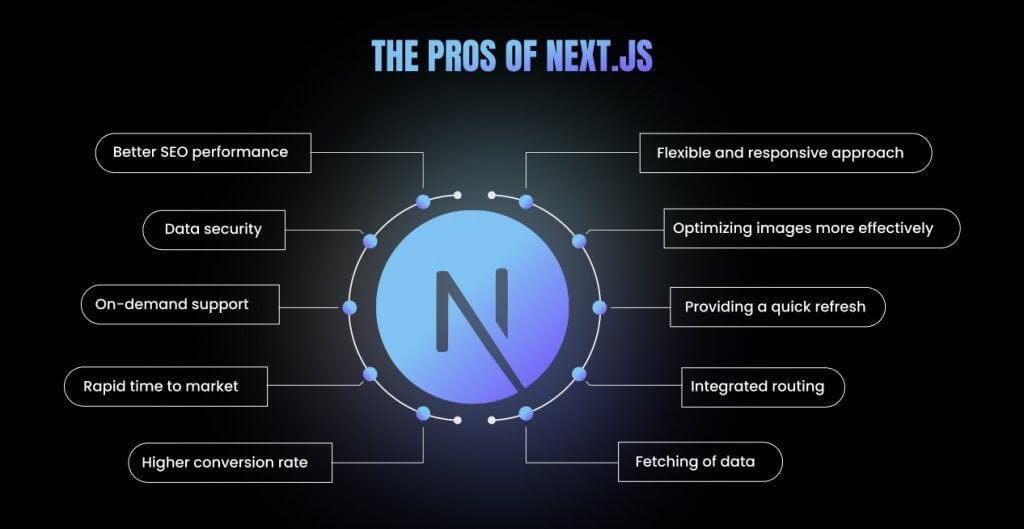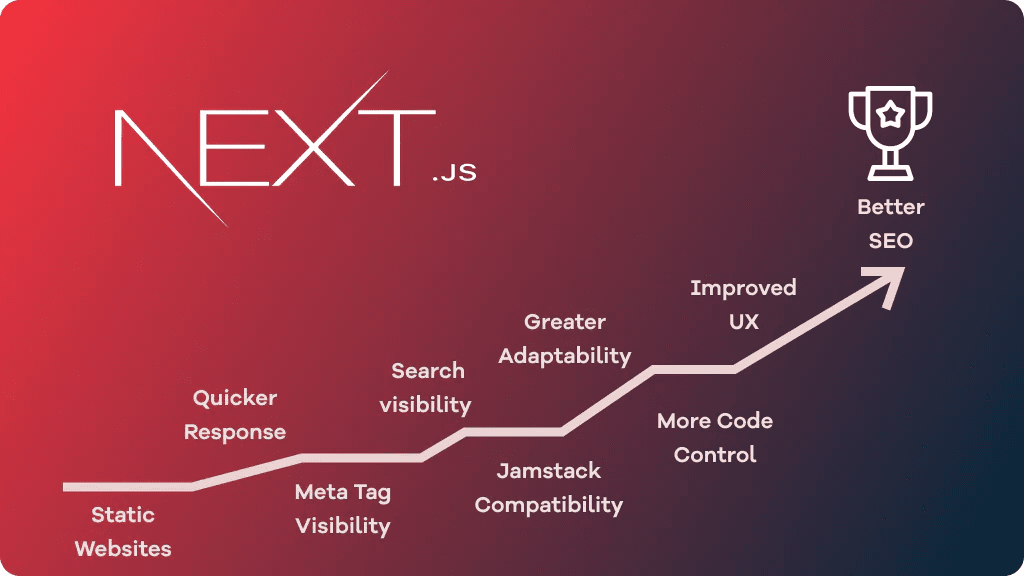In the rapidly evolving world of web development, choosing the right framework is crucial for success. With countless options available, developers often face the challenge of finding a tool that not only meets current demands but is also future-proof. Enter Next.js—an open-source React framework that has been making waves in the development community. From its performance-enhancing features to its SEO advantages, Next.js is proving to be a game-changer in the industry. This article delves into six key benefits of using Next.js and why it stands out as the future of modern web development.
Understanding Next.js
Before diving into its game-changing benefits, it's essential to understand what Next.js is and how it fits into the broader landscape of web development.
The Evolution of React and the Birth of Next.js
Next.js was created by Vercel and released in 2016 as a React-based framework designed to solve common challenges faced by developers building complex web applications. While React is a powerful JavaScript library for building user interfaces, it doesn't provide built-in solutions for tasks like server-side rendering, routing, or static site generation. Next.js fills these gaps, making it easier to build scalable, high-performance applications.
Core Features of Next.js That Developers Love
Next.js offers a range of features that streamline the development process. These include automatic code splitting, server-side rendering (SSR), static site generation (SSG), and built-in CSS support. The framework also provides a simple file-based routing system, making it easier to manage large applications. These features, among others, have contributed to Next.js's growing popularity among developers.
Comparing Next.js to Other Frameworks
When compared to other frameworks like Angular, Vue.js, or even plain React, Next.js offers unique advantages, particularly in terms of performance, SEO, and developer experience. While each framework has its strengths, Next.js's ability to seamlessly integrate with React while adding powerful features like SSR and SSG sets it apart as a versatile and future-proof option.

The Game-Changing Benefits of Next.js
Now that we have a foundational understanding of Next.js, let's explore the six key benefits that make it a game-changer in modern web development.
Enhanced Performance and Speed
One of the most significant advantages of using Next.js is the enhanced performance it offers right out of the box.
Automatic Code Splitting for Optimized Load Times
Next.js automatically splits your code into smaller bundles, meaning only the necessary parts of your application are loaded at any given time. This leads to faster load times and a smoother user experience, particularly on slower networks or less powerful devices. Unlike traditional single-page applications (SPAs), where the entire JavaScript bundle is loaded upfront, Next.js ensures that each page only loads the code it needs.
Image Optimization with Built-In Tools
Next.js includes built-in image optimization, which automatically compresses and resizes images based on the user's device and screen size. This reduces the amount of data that needs to be downloaded, further improving page load times. Additionally, Next.js supports modern image formats like WebP, which offer better compression rates compared to traditional formats like JPEG and PNG.
Fast Refresh for a Seamless Development Experience
During development, Next.js offers a feature called Fast Refresh, which allows developers to see their changes in real-time without losing the application state. This dramatically improves the development workflow by reducing the time spent on rebuilding and reloading the application, enabling developers to iterate quickly and efficiently.

SEO Optimization Out of the Box
Search engine optimization (SEO) is a critical consideration for any web application, particularly those that rely on organic traffic. Next.js provides several features that help improve SEO without requiring additional configuration.
Server-Side Rendering (SSR) and Its Impact on SEO
One of the main SEO benefits of Next.js is its support for server-side rendering (SSR). With SSR, pages are rendered on the server and sent to the client as fully-formed HTML. This is in contrast to client-side rendering (CSR), where the browser must download JavaScript and render the page itself. SSR ensures that search engine crawlers can easily index your pages, improving visibility and search rankings.
Dynamic Routing and Page-Level Control
Next.js's file-based routing system allows for dynamic routing, where you can easily create dynamic pages that are SEO-friendly. Each route corresponds to a file in your project, and you can configure metadata, headers, and other SEO elements on a per-page basis. This level of control ensures that your site is optimized for search engines at both the global and individual page levels.
Structured Data Integration for Better Search Rankings
Structured data helps search engines understand the content of your pages, leading to better search rankings and rich snippets. Next.js makes it easy to integrate structured data into your application, allowing you to provide detailed information about your content to search engines like Google.
Seamless Integration with React and Ecosystem
Next.js builds on the foundation of React, one of the most popular JavaScript libraries for building user interfaces. This seamless integration offers several benefits.
Building on Familiar React Principles
For developers already familiar with React, Next.js provides a natural extension of the library's principles. You can continue to use all your favorite React components, hooks, and libraries while taking advantage of the additional features Next.js offers. This familiarity reduces the learning curve and accelerates development.
Simplifying Server-Side Rendering (SSR) with React Components
While SSR can be challenging to implement in a plain React application, Next.js simplifies the process by handling the server-side rendering for you. This means you can focus on building your React components without worrying about the complexities of SSR, making it easier to build high-performance, SEO-friendly applications.
Leveraging React’s Vast Ecosystem with Next.js
Next.js allows you to leverage the vast ecosystem of React libraries and tools. Whether you need a state management solution like Redux, a UI framework like Material-UI, or testing tools like Jest, you can easily integrate them into your Next.js application. This flexibility makes Next.js a versatile choice for any project, whether you're building a small personal site or a large-scale enterprise application.
Improved Developer Experience
Next.js is designed with developers in mind, offering features that streamline the development process and improve productivity.
Hot Module Replacement and Fast Refresh
Hot Module Replacement (HMR) is a feature that allows you to update modules in your application without requiring a full reload. Combined with Fast Refresh, HMR ensures that changes are applied instantly, maintaining the application state and reducing development time. This feature is particularly useful for large applications where full reloads can be time-consuming.
Integrated TypeScript Support for Robust Development
TypeScript is becoming increasingly popular in the development community due to its ability to catch errors at compile-time rather than runtime. Next.js includes integrated support for TypeScript, allowing you to add type-checking to your application with minimal configuration. This leads to more robust and maintainable code, reducing the likelihood of bugs and improving overall code quality.
Simplified API Routes and Data Fetching
Next.js simplifies the process of creating API routes and fetching data from external sources. With API routes, you can easily create serverless functions that handle backend logic, making it easier to build full-stack applications. Additionally, Next.js provides several methods for data fetching, including getStaticProps, getServerSideProps, and getStaticPaths, giving you flexibility in how you fetch and manage data.

Scalability and Flexibility
As web applications grow in complexity and scale, the need for a framework that can handle large amounts of traffic and data becomes crucial. Next.js excels in this area by offering scalability and flexibility.
Static Site Generation (SSG) for Large-Scale Applications
Static Site Generation (SSG) is a feature that allows you to pre-render pages at build time. This means that the pages are generated once and served as static files, resulting in faster load times and reduced server load. SSG is particularly beneficial for large-scale applications with many pages, as it ensures consistent performance even under heavy traffic.
Hybrid Applications with Both SSG and SSR
Next.js allows you to build hybrid applications that combine both SSG and SSR. This flexibility enables you to choose the best rendering strategy for each page or section of your application. For example, you might use SSG for marketing pages that need to load quickly and SSR for dynamic pages that require up-to-date data.
Easy Deployment with Vercel and Other Platforms
Next.js is closely integrated with Vercel, the platform created by the same team that built Next.js. Vercel offers seamless deployment, scaling, and monitoring for Next.js applications, making it easy to go from development to production. Additionally, Next.js can be deployed on other platforms like Netlify, AWS, or even your own servers, giving you flexibility in how and where you deploy your application.
Strong Community and Ecosystem Support
A thriving community and strong ecosystem are crucial for the long-term success of any technology, and Next.js excels in both areas.
Active and Growing Community of Developers
Next.js has a large and active community of developers who contribute to its continuous improvement. Whether you're looking for help with a specific issue, seeking advice on best practices, or wanting to contribute to the project yourself, you'll find a welcoming and supportive community.
Extensive Documentation and Learning Resources
Next.js provides extensive documentation that covers everything from getting started to advanced topics. The documentation is well-organized, easy to follow, and includes examples to help you understand how to use the framework effectively. Additionally, there are numerous tutorials, courses, and resources available online to help you learn Next.js at your own pace.
Continuous Updates and Improvements from Vercel
As the creators of Next.js, Vercel is committed to continuously improving the framework. New features, bug fixes, and performance enhancements are regularly released, ensuring that Next.js remains at the cutting edge of web development. This ongoing support and development make Next.js a reliable choice for long-term projects.
Use Cases and Real-World Examples of Next.js
To fully appreciate the impact of Next.js, it's helpful to look at how it has been successfully implemented in real-world projects.
Case Studies of Successful Next.js Implementations
Many companies have adopted Next.js for their web applications, leveraging its performance and scalability benefits. For example, companies like Hulu, Twitch, and TikTok have used Next.js to build dynamic, user-friendly applications that can handle millions of users.
Popular Companies and Projects Using Next.js
Next.js is used by some of the biggest names in tech, including Uber, Netflix, and GitHub. These companies rely on Next.js to build fast, scalable, and reliable applications that meet the demands of their global user bases. The adoption of Next.js by these industry leaders is a testament to its capabilities and effectiveness.

Challenges and Considerations When Using Next.js
While Next.js offers many benefits, it's important to consider potential challenges before adopting it for your project.
Potential Learning Curve for New Developers
For developers who are new to React or server-side rendering, there may be a learning curve when first starting with Next.js. The framework introduces concepts like SSR, SSG, and API routes, which may be unfamiliar to those used to working with traditional client-side frameworks. However, the learning curve is often worth the investment, as the benefits of using Next.js can greatly outweigh the initial challenges.
Common Pitfalls and How to Avoid Them
As with any technology, there are potential pitfalls when using Next.js. For example, improper use of SSR can lead to performance bottlenecks, and failing to optimize images can slow down your application. To avoid these issues, it's essential to follow best practices and leverage the tools and resources provided by the Next.js community.
Conclusion
Next.js has proven itself to be a game-changer in modern web development, offering enhanced performance, SEO optimization, seamless integration with React, and a host of other benefits that make it an ideal choice for developers. By understanding and leveraging the six key benefits outlined in this article, developers can build high-performance, scalable, and future-proof applications that meet the demands of today's fast-paced digital landscape.
As the web continues to evolve, Next.js stands out as a framework that not only addresses current challenges but also sets the stage for the future of web development. Whether you're building a small personal project or a large-scale enterprise application, Next.js offers the tools and flexibility you need to succeed. So, if you haven't already, it's time to explore and adopt Next.js for your next project. You'll be glad you did.
FAQs
What is Next.js and why is it important?
Next.js is a React-based framework that simplifies the development of server-rendered and statically generated web applications. It's important because it offers features like automatic code splitting, server-side rendering (SSR), and static site generation (SSG) that improve performance, SEO, and the overall development experience.
How does Next.js improve performance?
Next.js improves performance through features like automatic code splitting, which reduces the amount of code that needs to be loaded at once, and built-in image optimization, which compresses and resizes images for faster load times. These features ensure that your application loads quickly, even on slower networks.
Why is SEO better with Next.js?
Next.js enhances SEO by supporting server-side rendering (SSR), which ensures that search engines can easily index your pages. Additionally, Next.js's file-based routing and dynamic routing features allow for precise control over page-level SEO elements, improving search rankings.
What are the main advantages of using Next.js over plain React?
Next.js builds on React by adding features like server-side rendering (SSR), static site generation (SSG), and file-based routing, which are not available in plain React. These features make it easier to build high-performance, SEO-friendly applications with less effort.
Is Next.js suitable for large-scale applications?
Yes, Next.js is highly scalable and suitable for large-scale applications. It offers features like static site generation (SSG) and hybrid rendering (combining SSG and SSR), which allow for efficient handling of large amounts of traffic and data.
How does Next.js simplify the development process?
Next.js simplifies the development process by offering a robust set of built-in features, such as API routes, data fetching methods, and integrated TypeScript support. These features reduce the need for third-party tools and libraries, streamlining the development workflow and improving productivity.







